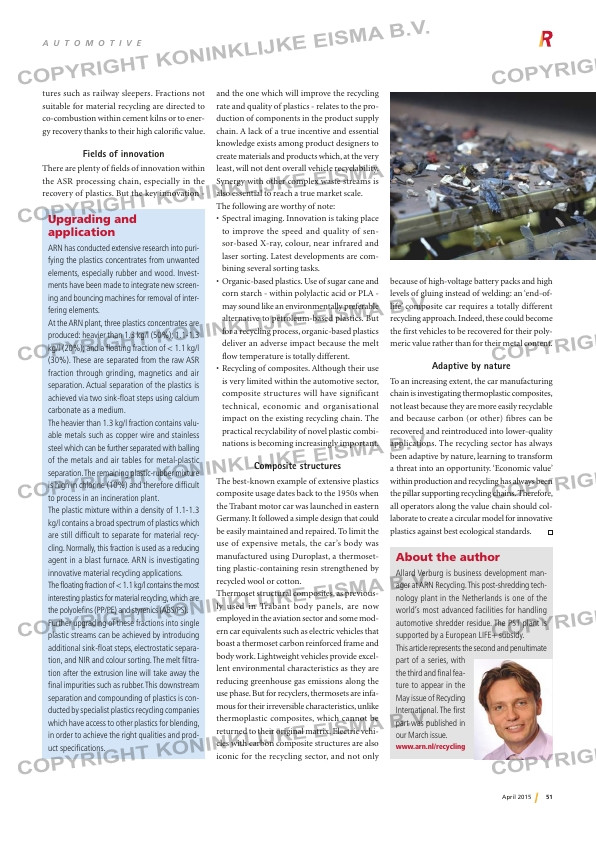Page 51 from: April 2015

51April 2015
A U T O M O T I V E
Upgrading and
application
ARN has conducted extensive research into puri-
fying the plastics concentrates from unwanted
elements, especially rubber and wood. Invest-
ments have been made to integrate new screen-
ing and bouncing machines for removal of inter-
fering elements.
At the ARN plant, three plastics concentrates are
produced: heavier than 1.3 kg/l (50%); 1.1-1.3
kg/l (20%); and a floating fraction of < 1.1 kg/l
(30%). These are separated from the raw ASR
fraction through grinding, magnetics and air
separation. Actual separation of the plastics is
achieved via two sink-float steps using calcium
carbonate as a medium.
The heavier than 1.3 kg/l fraction contains valu-
able metals such as copper wire and stainless
steel which can be further separated with balling
of the metals and air tables for metal-plastic
separation. The remaining plastic-rubber mixture
is high in chlorine (10%) and therefore difficult
to process in an incineration plant.
The plastic mixture within a density of 1.1-1.3
kg/l contains a broad spectrum of plastics which
are still difficult to separate for material recy-
cling. Normally, this fraction is used as a reducing
agent in a blast furnace. ARN is investigating
innovative material recycling applications.
The floating fraction of < 1.1 kg/l contains the most
interesting plastics for material recycling, which are
the polyolefins (PP/PE) and styrenics (ABS/PS).
Further upgrading of these fractions into single
plastic streams can be achieved by introducing
additional sink-float steps, electrostatic separa-
tion, and NIR and colour sorting. The melt filtra-
tion after the extrusion line will take away the
final impurities such as rubber. This downstream
separation and compounding of plastics is con-
ducted by specialist plastics recycling companies
which have access to other plastics for blending,
in order to achieve the right qualities and prod-
uct specifications.
About the author
Allard Verburg is business development man-
ager at ARN Recycling. This post-shredding tech-
nology plant in the Netherlands is one of the
world’s most advanced facilities for handling
automotive shredder residue. The PST plant is
supported by a European LIFE+ subsidy.
This article represents the second and penultimate
part of a series, with
the third and final fea-
ture to appear in the
May issue of Recycling
International. The first
part was published in
our March issue.
www.arn.nl/recycling
and the one which will improve the recycling
rate and quality of plastics – relates to the pro-
duction of components in the product supply
chain. A lack of a true incentive and essential
knowledge exists among product designers to
create materials and products which, at the very
least, will not dent overall vehicle recyclability.
Synergy with other complex waste streams is
also essential to reach a true market scale.
The following are worthy of note:
• Spectral imaging. Innovation is taking place
to improve the speed and quality of sen-
sor-based X-ray, colour, near infrared and
laser sorting. Latest developments are com-
bining several sorting tasks.
• Organic-based plastics. Use of sugar cane and
corn starch – within polylactic acid or PLA –
may sound like an environmentally preferable
alternative to petroleum-based plastics. But
for a recycling process, organic-based plastics
deliver an adverse impact because the melt
flow temperature is totally different.
• Recycling of composites. Although their use
is very limited within the automotive sector,
composite structures will have significant
technical, economic and organisational
impact on the existing recycling chain. The
practical recyclability of novel plastic combi-
nations is becoming increasingly important.
Composite structures
The best-known example of extensive plastics
composite usage dates back to the 1950s when
the Trabant motor car was launched in eastern
Germany. It followed a simple design that could
be easily maintained and repaired. To limit the
use of expensive metals, the car’s body was
manufactured using Duroplast, a thermoset-
ting plastic-containing resin strengthened by
recycled wool or cotton.
Thermoset structural composites, as previous-
ly used in Trabant body panels, are now
employed in the aviation sector and some mod-
ern car equivalents such as electric vehicles that
boast a thermoset carbon reinforced frame and
body work. Lightweight vehicles provide excel-
lent environmental characteristics as they are
reducing greenhouse gas emissions along the
use phase. But for recyclers, thermosets are infa-
mous for their irreversible characteristics, unlike
thermoplastic composites, which cannot be
returned to their original matrix. Electric vehi-
cles with carbon composite structures are also
iconic for the recycling sector, and not only
because of high-voltage battery packs and high
levels of gluing instead of welding: an ‘end-of-
life’ composite car requires a totally different
recycling approach. Indeed, these could become
the first vehicles to be recovered for their poly-
meric value rather than for their metal content.
Adaptive by nature
To an increasing extent, the car manufacturing
chain is investigating thermoplastic composites,
not least because they are more easily recyclable
and because carbon (or other) fibres can be
recovered and reintroduced into lower-quality
applications. The recycling sector has always
been adaptive by nature, learning to transform
a threat into an opportunity. ‘Economic value’
within production and recycling has always been
the pillar supporting recycling chains. Therefore,
all operators along the value chain should col-
laborate to create a circular model for innovative
plastics against best ecological standards.
tures such as railway sleepers. Fractions not
suitable for material recycling are directed to
co-combustion within cement kilns or to ener-
gy recovery thanks to their high calorific value.
Fields of innovation
There are plenty of fields of innovation within
the ASR processing chain, especially in the
recovery of plastics. But the key innovation –
RI-3 ARN Part 2.indd 51 30-03-15 12:24



